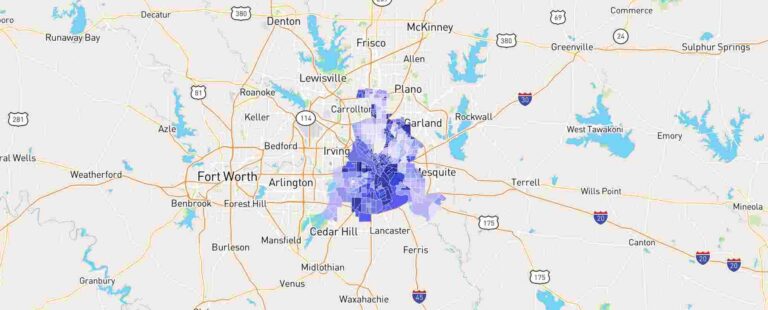Addressing the Rising Crime Crisis in Downtown Dallas: A Comparative Analysis with Fort Worth
Downtown Dallas Confronts a Surge in Crime Relative to Fort Worth
Recent crime statistics reveal a troubling trend: Downtown Dallas is experiencing criminal activity at a rate nearly five times higher than that of Downtown Fort Worth. This alarming increase has sparked widespread concern among community members and city officials, underscoring the urgent need for focused crime prevention efforts and enhanced policing strategies. The most vulnerable zones include commercial hubs, public transit areas, and nightlife districts, where dense crowds and limited surveillance create opportunities for criminal acts.
Primary contributors to DallasŌĆÖs crime escalation include:
- Rapid urban expansion outstripping public safety resources
- Elevated levels of both violent and property-related offenses
- Strained relations between law enforcement and local communities affecting crime reporting
- Unequal distribution of policing resources compared to neighboring cities
| Metric | Downtown Dallas | Downtown Fort Worth |
|---|---|---|
| Average Monthly Reported Crimes | 250 | 50 |
| Violent Crime Incidents | 85 | 20 |
| Property Crime Incidents | 165 | 30 |
| Number of Assigned Police Officers | 120 | 100 |
Exploring the Root Causes Behind the Crime Rate Gap
Economic and social dynamics significantly influence the disparity in crime rates between Downtown Dallas and Fort Worth. DallasŌĆÖs urban core is marked by stark contrasts, with affluent neighborhoods adjacent to economically disadvantaged areas. Higher unemployment rates and limited access to essential social services in Dallas contribute to increased incidences of theft, assaults, and other crimes. Moreover, the cityŌĆÖs dense population and vibrant nightlife create conditions conducive to criminal behavior, unlike Fort WorthŌĆÖs more residential and suburban environment.
Differences in policing approaches and community engagement also play a crucial role. Fort Worth has prioritized neighborhood policing and invested in proactive crime prevention programs, fostering stronger community ties. Conversely, Dallas faces challenges in effectively allocating resources across its expansive downtown area. Key factors influencing the crime disparity include:
- Population concentration: DallasŌĆÖs higher density complicates surveillance and law enforcement efforts.
- Public transit systems: Extensive transit options in Dallas sometimes facilitate transient criminal activity.
- Community involvement: Fort WorthŌĆÖs active neighborhood partnerships contribute to more effective crime deterrence.
| Factor | Downtown Dallas | Downtown Fort Worth |
|---|---|---|
| Unemployment Rate | 8.5% | 5.3% |
| Population Density (per sq mi) | 9,000 | 3,200 |
| Neighborhood Policing Coverage | 65% | 90% |
| Number of Nightlife Venues | 120 | 45 |
Consequences of the Crime Increase on Businesses and Residents
The uptick in criminal activity has had a profound impact on both local enterprises and residents, threatening the economic health and community spirit of Downtown Dallas. Many small businesses report a decline in customer visits, largely driven by fears of theft, vandalism, and violent encounters. This has forced companies to allocate more funds toward security enhancements, including advanced surveillance technology, private security personnel, and fortified storefronts. Neighborhoods once bustling with activity now face the challenge of restoring a sense of safety and trust among daily visitors and inhabitants.
Residents are also feeling the strain of the rising crime wave. Concerns over personal safety have led to lifestyle adjustments such as avoiding nighttime outings and modifying travel routes. The psychological and practical repercussions include:
- Declining property values due to increased perceptions of risk
- Challenges in attracting new residents and skilled professionals to the area
- Reduced participation in community events, weakening neighborhood bonds
Recent economic data illustrates these effects:
| Sector | Revenue Decline (%) | Increase in Security Costs (%) |
|---|---|---|
| Retail | 18 | 25 |
| Hospitality | 22 | 30 |
| Residential | ŌĆö | 15 |
Proposed Strategies to Bolster Safety in Downtown Dallas
Combating the rising crime rates in Downtown Dallas demands a comprehensive strategy that integrates community collaboration with cutting-edge policing methods. Strengthening partnerships between law enforcement, local businesses, and neighborhood groups is essential to establish swift communication and coordinated responses. Incorporating advanced technologies such as AI-powered surveillance systems and predictive crime analytics can enhance the ability to identify and address high-risk areas proactively. Building trust through transparency and accountability remains a cornerstone of effective crime reduction.
Recommended initiatives include:
- Expanding community policing programs focused on fostering positive relationships
- Enhancing street lighting and installing additional surveillance cameras in vulnerable zones
- Increasing investment in mental health crisis response teams
- Launching youth engagement programs aimed at preventing gang involvement
- Utilizing data analytics to optimize patrol routes and resource deployment
| Initiative | Projected Outcome | Implementation Timeline |
|---|---|---|
| AI-Enhanced Surveillance | 30% decrease in property crimes | 6 months |
| Community Policing Expansion | Improved public trust and crime reporting | 12 months |
| Youth Outreach Programs | Reduction in gang recruitment | 18 months |
Final Thoughts
The pronounced difference in crime rates between Downtown Dallas and Fort Worth calls for a critical examination of the factors fueling this divide. While Dallas contends with a higher volume of criminal incidents, Fort WorthŌĆÖs relatively lower rates reflect distinct community dynamics and policing models. Moving forward, Dallas must prioritize innovative, community-centered approaches to crime prevention and public safety enhancement. Ongoing data analysis and active citizen engagement will be vital to fostering a secure and thriving urban environment for all residents and visitors.







